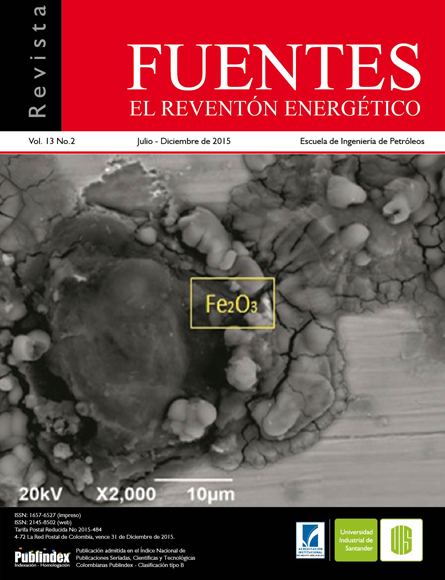Publicado 2015-12-03
Palabras clave
- Proceso de inyección de agua,
- Terminación inteligente,
- Método de Hall,
- Zonas de inyección,
- Factor de recobro
- Eficiencia de barrido ...Más
Cómo citar
Resumen
La recuperación de hidrocarburos a través del proceso de inyección de agua es el método que más ha contribuido a la recuperación de petróleo a nivel mundial, sin embargo, las características cambiantes en yacimiento ocasionan un barrido inefi ciente de petróleo y un alto costo operacional.
El trabajo presenta una reflexión de los métodos de control y monitoreo implementados en los procesos de inyección de agua los cuales permiten realizar un barrido eficiente e incrementar los porcentajes de petróleo recuperado. Basándose en esta investigación se desarrolla una propuesta metodológica que describe un sistema de control empleando sartas selectivas con válvulas de control de fl ujo accionadas desde superficie (terminaciones inteligentes) y un sistema de supervision empleando un método de diagnóstico llamado Método de Hall Revisado que en conjunto busca la máxima recuperación económica del yacimiento.
Descargas
Referencias
2. Aljuri, C. C. (2005). Creación y desarrollo de la base de datos para el monitoreo de la inyección de agua en el campo Caño Limón - Arauca. Tesis pregrado, Facultad de Ingenierias Fisico-Quimicas. Universidad Industrial de Santander, Bucaramanga, Santander, 168pp.
3. Arashi, A., & Konopczynski, M. (2003). A Dynamic Optimisation Technique for Simulation of MultiZone Intelligent Well Systems in a Reservoir Development. Offshore Europe. Aberdeen, United Kingdom: SPE 83963.
4. Asadollahi, M. (2012). Waterflooding Optimization for Improved Reservoir Management. Tesis PhD. Faculty of Engineering Science and Technology. University of Science and Technology (NTNU), Trondheim, Norway, 145pp.
5. Atayero, A., Alatishe, A., & Ivanov, Y. (2012). Power Line Communication Technologies: Modeling and Simulation of PRIME Physical Layer. Proceedings of the World Congress on Engineering and Computer Science. San Francisco, USA: WCECS.
6. Bailey, B., Crabtree, M., Tyrie, J., Elphick, J., Kuchuk, F., Romano, C., & Roodhart, L. (2000). Control del agua. Oilfield Review, 12(1), 32 - 53.
7. Beveridge, K., Eck, J., Goh, G., Izetti, R., Jadid, M., & Scamparini, G. (2011). Terminaciones inteligentes modulares. Oilfield Review, 23(3), 18-27.
8. De, A., Silin, D., & Patzek, T. (2000). Waterflood Surveillance and Supervisory Control. SPE/ DOE Improved Oil Recovery Symposium. Tulsa, Oklahoma: SPE 59295.
9. Doublet, L. E., & Blasingame, T. (1996). Evaluation of Injection Well Performance Using Decline Type Curves. SPE Pennian Basin Oil and Gas Recovery Conference. Midland, Texas: SPE 35205.
10. Dyer, S., El-Khazindar, Y., Huber, M., Raw, I., & Reed, D. (2008). Terminaciones inteligentes: Manejo automatizado de pozos. Oilfield Review, 19(4), 4-17.
11. Ebadi, F., & Davies, D. (2006). Should “Proactive” or “Reactive” Control be Chosen for Intelligent Well Management? Intelligent Energy Conference and Exhibition. Amsterdam, The Netherlands: SPE 99929.
12. Fedenczuk, L., & Calgary, A. (2003). Monitoring, analyzing, and optimizing Waterflood Responses. SAS Conference Proceedings. Seattle, Washington: SUGI 28.
13. Hall, H. N. (1963). How to analyze waterflood injection well performance. World Oil, Octubre, 128-130.
14. IHS. (2014). Surveillance Analysis Theory. Retrieved from Fekete: http://www.fekete.com/SAN/ WebHelp/FeketeHarmony/Harmony_WebHelp/ Content/HTML_Files/Reference_Material/ Analysis_Method_Theory/Surveillance_Theory. htm
15.Jarrell, P., & Stein, M. (1991). Maximizing Injection Rates in Wells Recently Converted to Injection Using Hearn and Hall Plots. SPE Production Operations Symposium. Oklahoma City, Oklahoma: SPE 21724.
16. Mihcakan, I. M., Altinay, E., & Kasap, I. (2005). The Hall Plot Analysis of a Water Injection Test Affected by Geothermal Reservoir Response. Proceedings World Geothermal Congress. Antalya, Turkey.
17. Montaron, B., & Vasper, A. (2007). Intelligent Completions. Middle East & Asia Reservoir Review, 8, 6-21.
18. Naevdal, G., Brouwer, R., & Jansen, J. D. (2006). Waterflooding using closed loop control. Computational Geosciences, 10(1), 37-60.
19. Sakowski, S., Anderson, A. B., & Furui, K. (2005). Impact of Intelligent Well Systems on Total Economics of Field Developments. SPE Hydrocarbon Economics and Evaluation Symposium. Dallas, Texas: SPE 94672.
20. Saputelli, L., Ramirez, K., Chegin, J., & Cullick, S. (2009). Waterflood Recovery Optimization Using Intelligent Wells and Decision Analysis. Latin American and Caribbean Petroleum Engineering Conference. Cartagena, Colombia: SPE 120509.
21. Schrader, K. (2007). Intelligent completion reaches the dawn of its second decade. Recuperado el 20 de 05 de 2015, de Offshore: http://www.offshore-mag. com/articles/print/volume-67/issue 12/drillingcompletion/intelligent-completion-reaches-thedawn-of-its-second-decade.html
22. Silin, D. B., Holtzman , M. J., Patzek , T. W., Brink, J., & Minner, M. (Octubre 2005). Waterflood Surveillance and Control: Incorporating Hall Plot and Slope Analysis. Proceedings of SPE Annual Technical Conference and Exhibition. Dallas, Texas: SPE 93879.
23. Silin, D. B., Holtzman, R., & Patzek, T. W. (Abril 2005). Monitoring Waterflood Operations: Hall Method Revisited. Proceedings of SPE Western Regional Meeting. Irvine, California: SPE 95685.
24. Terrado, M., Yudono, S., & Thakur, G. (2007). Waterflooding Surveillance and Monitoring: Putting Principles Into Practice. Society of Petroleum Engineers, 10(5), 552-562.
25. Thakur, G. (1991). Waterflood surveillance Techniques - A Reservoir Management Approach. J. of Petrol. Technol., 43(10), 1-10.
26. Yang, Q., & Davies, D. (2009). A Generalized Predictive Control for Management of an Intelligent Well’s Downhole, Interval Control Valves - Design and Practical Implementation. Offshore Europe. Aberdeen, UK: SPE 123682
